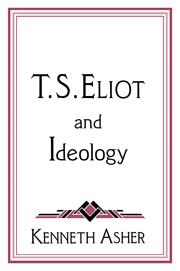4 - Architect of a Christian Order
Published online by Cambridge University Press: 05 June 2012
Summary
As long as Eliot faced his enemies as a classicist pitted against Romantics, he engaged them on the field of history. However outmoded and outmatched his values may now seem retrospectively, he – and his French sources – genuinely believed that those who held these values might prevail as architects of the twentieth century. It was they, after all, who had the weight of tradition behind them. Maurras, who never abandoned the field, continued to contend as a fascist, enjoying a brief moment of ascension under the Vichy government, followed by imprisonment and ignominy. Eliot, more flexible because younger and considerably less embittered, wisely refused this path. Instead, he ceded contemporary history to the heretics and tried to gather a saving remnant around him in anticipation of a better day. That this day would come he was confident, since for him the essence of the tradition, orthodoxy, was a continuous stream whose journey, as it now appeared, happened to be in part underground. So sure was he of ultimate vindication that whereas the earlier, classical Eliot had tried in various forums to shape his age, the later, dogmatic Eliot, employing a form of ventriloquism popular in the thirties, gives the impression that history speaks through him:
The World is trying the experiment of attempting to form a civilized but non-Christian mentality. […]
- Type
- Chapter
- Information
- T. S. Eliot and Ideology , pp. 84 - 108Publisher: Cambridge University PressPrint publication year: 1995



